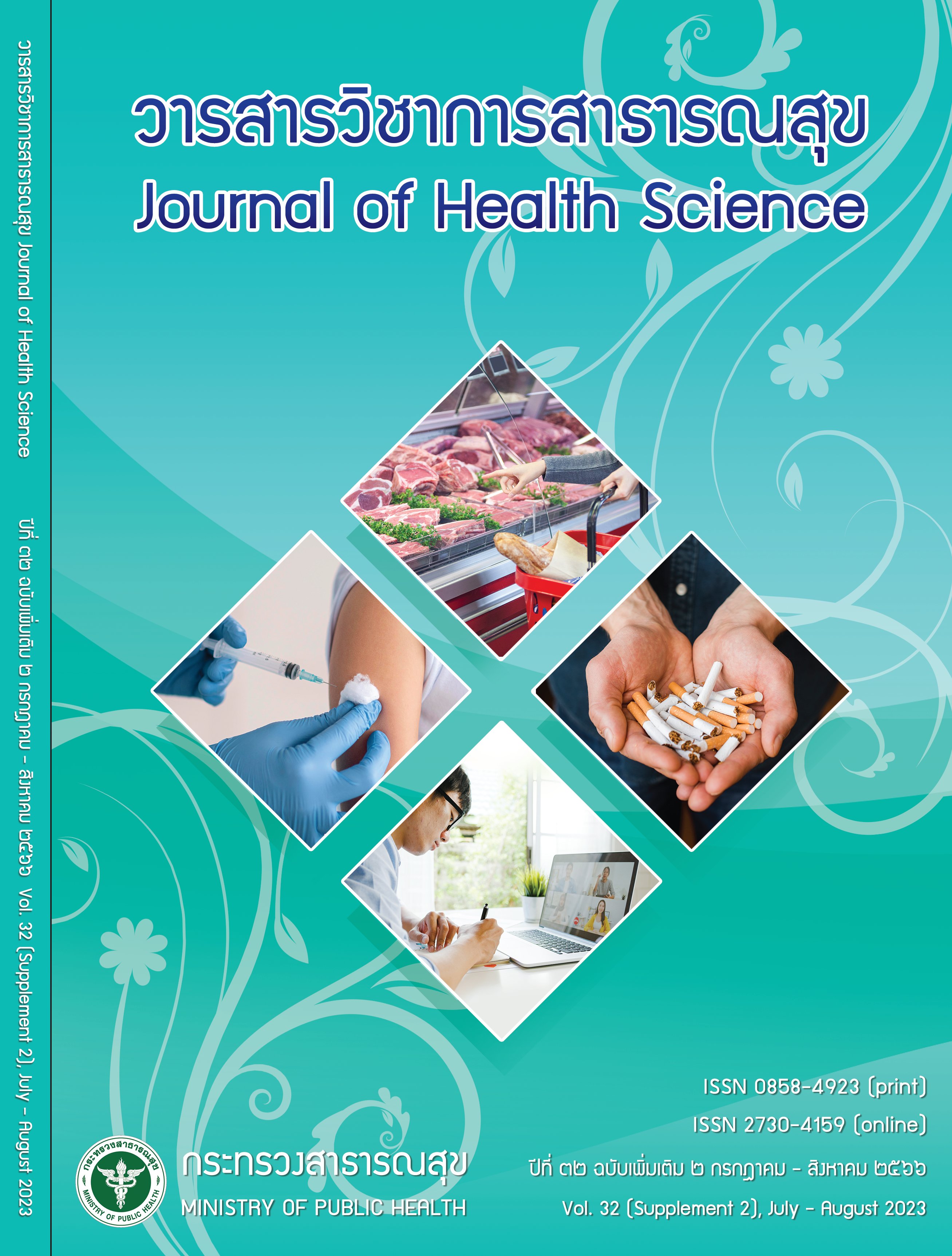Evaluation of the First 1,000 Days Miracles Program in Queen Sirikit Health Center 3 Public Health Region
Keywords:
evaluation, the first 1,000 days miracles program, Queen Sirikit Health CenterAbstract
This mixed-methods study aimed to evaluate the first 1,000 Days Miracles program in the Queen Sirikit Health Centers in the Public Health Region 3. Simple random sampling was utilized to select the study sites which included the Queen Sirikit health center in Bannongben, Nakhon Sawan Province, and Bantraitrueng, Kamphaeng Phet Province. The data were collected from 40 participants, with 20 participants from child and family care team (CFT) members from each center. Research tools included the CIPP evaluation model-based focus group discussions and project satisfaction survey forms verified by qualified experts. The project satisfaction survey forms content validity index of item-objective congruence (IOC) was 0.7-1.0. Cronbach’s alpha coefficient was utilized to evaluate reliability, and the results was 0.87. Data were collected at the beginning of May 2022 and evaluated using the group conversation. Qualitative data analysis employed content analysis, while quantitative data analysis used descriptive statistics. The results showed that: (1) context: the first 1,000 Days Miracles Program project responded to the target audiences, and the success factor in the operation was that the child & family care team realized the importance of health promotion for pregnant women and early childhood children. (2) Inputs: there were not enough varied network partners in the Child & Family Care Team Working Group, and the budget was insufficient. (3) Process: village health volunteers and local administrative bodies at the area level played an important role in the operation. (4) Product: the operating system for health promotion of pregnant women and early childhood children were developed. Moreover, the child & family care team working group’s satisfaction level with the project was high (Mean=4.1, SD=0.1). According to the findings of this study, there should be a community health development strategy and a network of collaborators in the child & family care team to promote the program. A development plan for community health volunteers should be developed to improve their knowledge of maternal and child health.
Downloads
References
กรมอนามัย กระทรวงสาธารณสุข. แนวทางการขับเคลื่อน มหัศจรรย์ 1,000 วันแรกของชีวิต. กรุงเทพมหานคร: เอวีโปรเกรสซีฟ; 2561.
Calderon J. Executive function in children: why it matters and how to help [Internet]. 2020 [cited 2023 Jun 9]. Available from: https://www.health.harvard.edu/blog/ executive-function-in-children-why-it-matters-andhow-to-help-2020121621583
จินตนา พัฒนพงศ์ธร. รายงานการศึกษาปัจจัยที่มีผลต่อ พัฒนาการเด็กปฐมวัยไทย ครั้งที่ 6 พ.ศ. 2560. นนทบุรี: สำนักส่งเสริมสุขภาพ กรมอนามัย; 2561.
สำนักโภชนาการ กรมอนามัย. แนวทางการดำเนินงานตำบลมหัศจรรย์ 1,000 วัน Plus สู่ 2,500 วัน. กรุงเทพมหานคร: ศูนย์สื่อและสิ่งพิมพ์แก้วเจ้าจอม มหาวิทยาลัยราชภัฏสวนสุนันทา; 2565.
ยุทธนา พูนพานิช. มาตรฐานการปฏิบัติงานโครงการ มหัศจรรย์ 1,000 วันแรกแห่งชีวิต เฉลิมพระเกียรติสมเด็จพระนางเจ้าสิริกิติ์ พระบรมราชชนนีพันปีหลวง ปี 2563 – 2564 [อินเทอร์เน็ต]. 2563 [สืบค้นเมื่อ 28 ธ.ค. 2565]. แหล่งข้อมูล: http://164.115.22.73/r9health/wp-content/uploads/2020/07/Miracle-1000-days-Queen17-July-2.pdf
ศูนย์อนามัยที่ 3 นครสวรรค์. อำนาจหน้าที่ตามกฎกระทรวง การแบ่งส่วนราชการกรมอนามัย กระทรวงสาธารณสุข พ.ศ. 2552 [อินเทอร์เน็ต]. 2565 [สืบค้นเมื่อ 28 ก.ย. 2565]. แหล่งข้อมูล: https://hpc3.anamai.moph.go.th/th/ authority
ศูนย์อนามัยที่ 3 นครสวรรค์. รายงานสถานการณ์ผลการ ดำเนินงานด้านอนามัยแม่และเด็ก ปี 2564. นครสวรรค์: ศูนย์อนามัยที่ 3 นครสวรรค์; 2564.
กรมสุขภาพจิต กระทรวงสาธารณสุข. เดินหน้า สร้างเด็กไทย ไอคิวดี. นนทบุรี: ชุมนุมสหกรณ์การเกษตรแห่งประเทศไทย; 2564.
สิรินรัตน์ แสงศิริรักษ์, เอกลักษณ์ แสงศิริรักษ์. ประสิทธิภาพ ของโครงการมหัศจรรย์ 1,000 วันแรกแห่งชีวิตต่อ พัฒนาการเด็ก. วารสารการแพทย์โรงพยาบาลศรีษะเกษ สุรินทร์ บุรีรัมย์ 2563;35(1):87-99.
เบญจมาภรณ์ ภิญโญพรพาณิชย์, ชัยพร สุชาติสุนทร, วิไลลักษณ์ เรืองรัตนตรัย. การปฏิรูปประเทศด้านสาธารณสุข กับความท้าทายระบบบริการปฐมภูมิ. วารสารควบคุมโรค 2565;48(3):667-79.
Stufflebeam DL, Shinkfield AJ. Evaluation theory, models & applications. San Fracisco, CA: John Wiley & Sons; 2007.
ชูศรี วงศ์รัตนะ. เทคนิคการใช้สถิติเพื่อการวิจัย. พิมพ์ครั้งที่ 13. กรุงเทพมหานคร: ศูนย์หนังสือจุฬาลงกรณ์มหาวิทยาลัย; 2560.
ชำนาญ ปาณาวงษ์. ระเบียบวิธีวิจัยเชิงคุณภาพ. พิษณุโลก: สำนักพิมพ์มหาวิทยาลัยนเรศวร; 2562.
World Health Organization. What matters to women during pregnancy: a different approach to antenatal care [Internet]. 2023 [cited 2023 Jun 9]. Available from: https:// www.who.int/news/item/08-03-2016-different-approach-to-antenatal-care
บำเพ็ญ พงศ์เพชรดิถ, บุษบา อรรถาวีร์. ปัจจัยที่ส่งผลต่อ พัฒนาการเด็กปฐมวัยไทย: ศูนย์อนามัยที่ 5. วารสารเกื้อการุณย์ 2563;27(1):59-70.
พิสิษฐ์ บุญถนอม, ปริญญา หรุ่นโพธิ์ . แนวทางการดำเนิน งานเพื่อความสำเร็จในการทำงานร่วมกันระหว่างผู้นำชุมชน กับองค์กรปกครองส่วนท้องถิ่น กรณีศึกษา: องค์การบริหาร ส่วนตำบลบางสะแก อำเภอ บางคนที จังหวัดสมุทรสงคราม. วารสารวิจัยและพัฒนา มหาวิทยาลัยราชภัฏสวนสุนันทา 2564;13(2):249-66
เพชรา ทองเผ้า, ดาราพร รักหน้าที่, กาญจนา ปัญญาธร, วัลภา ศรีบุญพิมพ์สวย. ความรู้ ทัศนคติ และการมีส่วนร่วม ของอาสาสมัครสาธารณสุขประจำหมู่บ้านในการส่งเสริมการ เลี้ยงลูกด้วยนมแม่. วารสารสุขภาพและการศึกษาพยาบาล 2565;28(1):1-15.
สำนักส่งเสริมสุขภาพ กรมอนามัย. คู่มือแนวทางการจัดบริการคลินิกเด็กสุขภาพดี. กรุงเทพมหานคร: องค์การสงเคราะห์ทหารผ่าศึก; 2565.
ภัทรพล จึงสมเจตไพศาล, สันติ ทวยมีฤทธิ์ . การพัฒนา รูปแบบการดำเนินงานโครงการมหัศจรรย์ 1,000 วันแรก แห่งชีวิตภายใต้กลไกคณะกรรมการพัฒนาคุณภาพชีวิต ระดับอำเภอ จังหวัดนครราชสีมา. วารสารวิชาการสาธารณสุข 2564;30(2):274-84.
อรอนงค์ บัวลา, ขนิษฐา นันทบุตร. ศักยภาพของชุมชนใน การสร้างเสริมสุขภาพของสตรีตั้งครรภ์โดยชุมชนเป็นฐาน. วารสารคณะพยาบาลศาสตร์ มหาวิทยาลัยบูรพา 2563; 28(2):16-26.
นลินี เกิดประสงค์, จันทิมา นวะมะวัฒน์. ระบบและกลไก เพื่อรองรับสังคมสูงอายุ ระดับตำบล. วารสารคณะพยาบาลศาสตร์ มหาวิทยาลัยบูรพา 2565; 30(1):49-63.
พรรณิภา อนุรักษากรกุล, สุวิมล เฮงพัฒนา. การจัดสรรงบประมาณรายจ่ายด้านสาธารณสุขกับคุณภาพชีวิตด้านสุขภาพ ของประชาชนระดับจังหวัด. วารสารวิชาการมนุษยศาสตร์และสังคมศาสตร์ มหาวิทยาลัยบูรพา 2563;28(1):195- 215.
วิราสิริริ์ วสีวีรสิว์. สถานการณ์และปัญหาการบริหารงานด้าน สาธารณสุขของผู้อำนวยการโรงพยาบาลส่งเสริมสุขภาพตำบล อำเภอบ้านหมี่ จังหวัดลพบุรี. วารสารกรมการแพทย์ 2560;42(6):108-11.
จิรณัฐ ชัยชนะ, กัญญดา ประจุศิลปะ. การศึกษาบทบาท พยาบาลวิชาชีพในโรงพยาบาลส่งเสริมสุขภาพตำบล. วารสารพยาบาลทหารบก 2561;19(ฉบับพิเศษ):193- 202.
สุธิสา กรายแก้ว. บทบาทหน้าที่ของอาสาสมัครสาธารณสุขประจำหมู่บ้านต่อการส่งเสริมสุขภาพประชาชน ตำบลขุนทะเล อำเภอเมือง จังหวัดสุราษฎร์ธานี. วารสารมหาจุฬานาครทรรศน์ 2563;7(12):69-81.
ไทยมณี ไชยฤทธิ์ . การจัดสวัสดิการแม่และเด็กขององค์กร ปกครองส่วนท้องถิ่น. วารสาร มจร. หริภุญ-ชัยปริทรรศน์ 2566;7(1):194-209.
อรพิน ปิยะสกุลเกียรติ. การมีส่วนร่วมของชุมชนในการ พัฒนาคุณภาพชีวิตผู้สูงอายุในตำบลท่าแค จังหวัดลพบุรี. วารสารร่มพฤกษ์ มหาวิทยาลัยเกริก 2561;36(3):45-65.
ยูนิเซฟ ประเทศไทย, กรมอนามัย, มหาวิทยาลัยมหิดล. การประเมินผลระหว่างการดำเนินโครงการมหัศจรรย์ 1,000 วัน แรกแห่งชีวิต [อินเทอร์เน็ต]. 2565 [สืบค้นเมื่อ 3 พ.ค. 2566]. แหล่งข้อมูล: https://www.unicef.org/thailand/ media/10646/file/Formative%20evaluation%20of%20 the%201000%20days%20programme%20TH.pdf
แววดี เหมวรานนท์. การประเมินผลการดำเนินงาน คณะกรรมการพัฒนาคุณภาพชีวิตระดับอำเภอ จังหวัด นครราชสีมา. วารสารวิจัยและพัฒนาด้านสุขภาพ สำนักงานสาธารณสุขจังหวัดนครราชสีมา 2563;6(1):140-57.
Downloads
Published
How to Cite
Issue
Section
License

This work is licensed under a Creative Commons Attribution-NonCommercial-NoDerivatives 4.0 International License.



